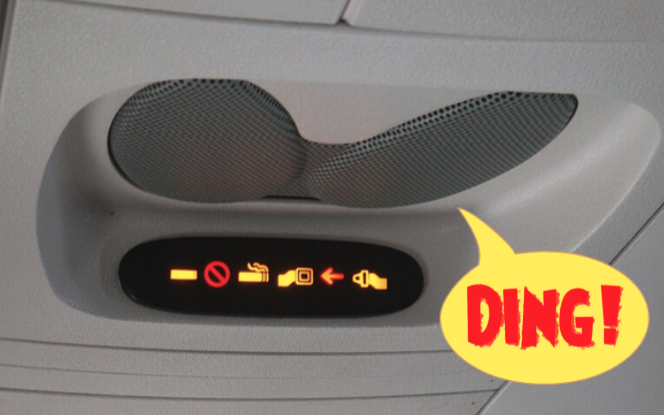For the vast majority of passengers, flying is simply a way to get from Point A to Point B. Of course, there are some passengers – frequent fliers, travel geeks, etc. – who know significantly more about the world of aviation. But for most of us, we don’t learn the little nuances about flying unless they’re taught stuff like:
- Secret code words and phrases that flight crew use
- Those mystery triangles on the cabin walls of a plane
- How to instantly tell the difference between an Airbus and a Boeing
- Why they dim the lights (or not) during takeoff/landing
Along those same lines, we got a lot of positive feedback not long ago, when we explained what the “dog barking” sound is on some planes. In response, a reader wrote and asked if we could explain another mystery sound for them – the “dings” you hear, here and there, when you’re on a plane. Of course, we can.
So, what ARE those “ding” sounds?
Some people call them “dings,” others refer to them as “chimes.” Either way, simply put, they’re a form of communication between the people on the flight deck and the flight crew in the cabin.
Typically, of course, communication by most people is done by talking. But if there’s little time to talk and you already know the “code” (think like Paul Revere’s “One if by land, two if by sea,” or even the Hanky Code), using sound can work just as well.
So here are the meanings of each ding:
The pilot typically “dings” three separate times per flight, and it’s to let them know that something routine has either happened or is about to happen.
First Ding
The first ding happens as the plane is taxiing out. You’ll hear an announcement that typically says, “Flight attendants, prepare for departure.” Once the plane has been cleared to go onto the runway, the pilot will give them one ding, which is to communicate to them to take their seats because they’re about to take off.
This is sometimes heard as having 2 dings (like a “ding-dong”). It depends on the airline.
Second Ding
The second ding happens once the plane has reached 10,000 feet. This is the way the pilot lets the flight attendants know that it’s now safe for them to get out of their seats. Sometimes the flight attendants will make an announcement to the passengers at that time that they’re free to move about the cabin, as well.
This is assuming the air is smooth. If there’s turbulence, this ding might be delayed.
Third Ding
The third ding happens upon descent. When the plane is approaching 10,000 feet, the cockpit dings one time to let the flight attendants know they need to finish up what they’re doing, because they only have about 12 to 15 minutes left before they have to take their seats because they’re getting ready to land.
Fun Fact! On some planes, they can use the knob for the “No Smoking” sign – they turn the sign off and back on really quick – to make the “ding” sound. (I admittedly don’t know if this is the case with all planes or not…aviation geeks, can you help a sister out, please and thank you?)
Here’s more information about it:
Other Dings You Might Hear
There are a few other dings you may hear on the flight.
Call bell ding
If a passenger hits the call bell, it makes a single ding sound (to get the flight attendants’ attention). It also lights up so the flight attendants know who pushed their button.
Flight attendants are contacting each other
If, during the flight, you hear a 2-tone ding (one high and one low – again, “ding-dong”), that typically means it’s one flight attendant (say, one who’s in the front of the plane) trying to get the attention of another flight attendant (who’s, let’s say, at the back of the plane), so they can talk to each other.
Three dings
Three dings have a couple of meanings, depending on the airline. It could mean:
- There’s an emergency on the plane
- The pilot could be telling the flight attendants to prepare for some bad turbulence coming up
Caveat: they’re not universal
It’s important to note that these dings, chimes or whatever you call them, are not universal. There are a lot of similarities but different carriers may have a different meaning for a ding or set of chimes.
Still, it gives you an idea.
Want to comment on this post? Great! Read this first to help ensure it gets approved.
Want to sponsor a post, write something for Your Mileage May Vary, or put ads on our site? Click here for more info.
Like this post? Please share it! We have plenty more just like it and would love it if you decided to hang around and sign up to get emailed notifications of when we post.
Whether you’ve read our articles before or this is the first time you’re stopping by, we’re really glad you’re here and hope you come back to visit again!
This post first appeared on Your Mileage May Vary
Join our mailing list to receive the latest news and updates from our team.

